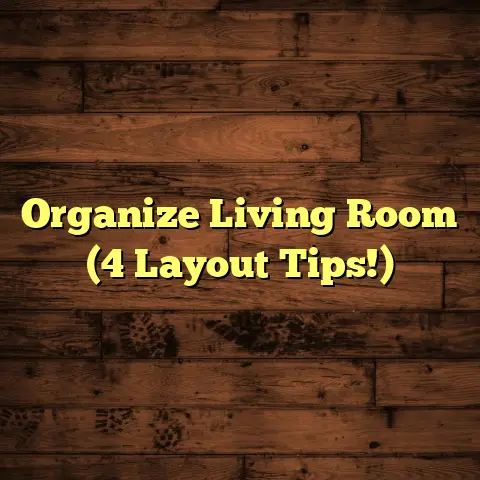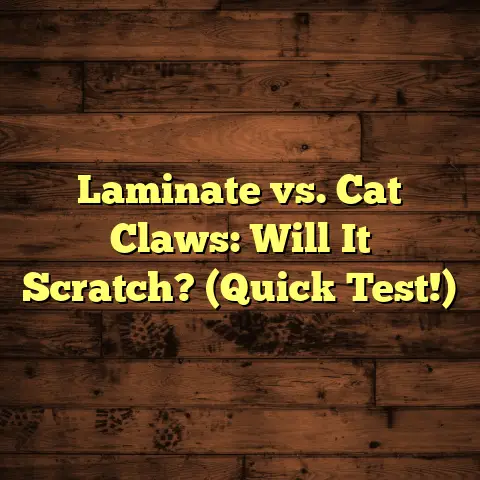Remove Novilon Flooring? (2 Tools You Need!)
If you’re anything like me, you’re always looking for ways to spruce up your home without breaking the bank.
And guess what? One of the easiest and most affordable ways to transform your space is by tackling that old, outdated flooring.
Specifically, I’m talking about removing Novilon flooring.
Trust me, it’s a lot simpler than you think, and with the right tools (just two!), you can have your floors prepped for a fresh new look in no time.
Ready to get started?
Section 1: Understanding Novilon Flooring
What is Novilon Flooring?
Okay, let’s get down to basics.
Novilon is a type of resilient flooring, similar to vinyl, that’s been around for quite a while.
It’s made from several layers, including a printed design layer, a foam layer for comfort, and a durable wear layer on top.
Think of it as a step up from basic sheet vinyl.
Novilon is known for being waterproof, easy to clean, and relatively comfortable underfoot.
You’ll often find it in kitchens, bathrooms, and other high-traffic areas in both homes and commercial spaces.
I’ve installed Novilon in quite a few rental properties because it holds up well to tenants.
Benefits of Novilon Flooring:
- Durability: Resists scratches, dents, and stains.
- Easy Maintenance: Just sweep and mop!
- Water Resistance: Great for wet areas.
- Comfort: The foam layer provides cushioning.
- Affordability: Typically cheaper than hardwood or tile.
- Aesthetic Appeal: Available in various patterns and colors.
Common Reasons for Removal
So, why would you want to rip out perfectly good Novilon flooring?
Well, there are a few reasons I’ve encountered over the years.
- Wear and Tear: Even durable flooring eventually shows its age. Scratches, scuffs, and fading can make it look tired.
- Damage: Accidents happen! Tears, gouges, or water damage can ruin the appearance and integrity of the flooring.
- Outdated Styles: Let’s face it, some patterns and colors just don’t age well. If your Novilon is screaming “1980s,” it might be time for an upgrade.
- Desire for New Materials: Maybe you’re dreaming of hardwood, tile, or laminate. Removing the Novilon is the first step to achieving your flooring dreams.
- Health Concerns: Older Novilon might contain harmful chemicals. Replacing it can improve your indoor air quality.
I remember one client who had Novilon installed in their kitchen back in the ’70s.
It was a bright orange floral pattern – definitely not in style anymore!
They were so excited to replace it with sleek, modern tiles.
Section 2: Essential Tools for Removal
Alright, let’s talk tools.
You might think you need a whole arsenal of equipment to remove Novilon flooring, but I’m here to tell you that’s not the case.
In my experience, you only need two essential tools to get the job done efficiently and safely.
Tool 1: Utility Knife
The humble utility knife is your best friend when it comes to flooring removal.
It’s the tool you’ll use to cut the Novilon into manageable pieces, making it easier to lift and remove.
Why a Utility Knife?
- Precision: Allows you to make clean, controlled cuts.
- Versatility: Can cut through various materials, including Novilon.
- Accessibility: Easy to find and relatively inexpensive.
How to Use a Utility Knife Effectively:
- Safety First: Always wear gloves to protect your hands.
- Extend the Blade: Extend the blade to a suitable length, usually about 1/2 to 3/4 of an inch. Make sure it’s locked securely in place.
- Score the Surface: Use the knife to score the Novilon along the seams or in a grid pattern. Apply firm, even pressure. You don’t need to cut all the way through on the first pass.
- Make Deeper Cuts: Go over the scored lines again, applying more pressure to cut through the Novilon completely.
- Work in Sections: Cut the Novilon into smaller sections, about 1-2 feet square. This makes it easier to handle and remove.
- Replace Blades Often: A sharp blade is essential for clean cuts and safety. Replace the blade as soon as it becomes dull.
Safety Tips:
- Always cut away from your body.
- Use a cutting board or other protective surface to avoid damaging the subfloor.
- Keep your fingers clear of the blade.
- Retract the blade when not in use.
- Dispose of used blades safely in a designated container.
Blade Types and Maintenance:
- Standard Blades: These are the most common type of utility knife blade. They’re suitable for most flooring removal tasks.
- Heavy-Duty Blades: These blades are thicker and stronger, making them ideal for cutting through tougher materials.
- Hook Blades: These blades have a curved hook shape, which is useful for cutting through carpet and other thick materials.
- To maintain your utility knife, clean it regularly with a dry cloth. Lubricate the blade occasionally with a light oil to prevent rust.
I always keep a multi-pack of blades on hand because there’s nothing worse than struggling with a dull blade.
Tool 2: Floor Scraper
Once you’ve cut the Novilon into sections, you’ll need a floor scraper to lift it off the subfloor.
A floor scraper is a tool with a long handle and a wide, flat blade that’s designed to scrape away flooring materials.
Why a Floor Scraper?
- Leverage: Provides leverage to lift stubborn flooring.
- Efficiency: Covers a large area quickly.
- Ergonomics: Reduces strain on your back and knees.
Types of Floor Scrapers:
- Handheld Scrapers: These are smaller scrapers with short handles. They’re good for detail work and tight spaces.
- Long-Handled Scrapers: These scrapers have long handles that allow you to stand upright while you work. They’re ideal for removing large areas of flooring.
- Razor Scrapers: These scrapers use razor blades for precision scraping. They’re useful for removing adhesive residue.
How to Choose the Right Floor Scraper:
- Handle Length: Choose a handle length that’s comfortable for you. A longer handle will reduce strain on your back.
- Blade Width: A wider blade will cover more area, but it may be harder to maneuver in tight spaces.
- Blade Material: Look for a scraper with a durable steel blade.
- Grip: Choose a scraper with a comfortable grip.
Step-by-Step Guide to Using a Floor Scraper:
- Position the Scraper: Place the blade of the scraper under the edge of the Novilon.
- Apply Pressure: Use your foot or hand to apply pressure to the scraper.
- Lift and Scrape: Lift the handle of the scraper to pry up the Novilon. Scrape the blade along the subfloor to remove any remaining adhesive.
- Work in Sections: Continue working in sections until you’ve removed all of the Novilon.
- Maintain the Blade: Keep the blade sharp for optimal performance. Sharpen it as needed with a file or grinder.
Safety Precautions:
- Wear safety glasses to protect your eyes from flying debris.
- Wear gloves to protect your hands from cuts and scrapes.
- Use caution when working around nails, staples, or other sharp objects.
- Keep the blade sharp for optimal performance.
I prefer a long-handled scraper with a wide blade because it allows me to work quickly and efficiently without killing my back.
Section 3: Step-by-Step Guide to Removing Novilon Flooring
Okay, now that we’ve covered the tools, let’s get into the nitty-gritty of removing Novilon flooring.
Preparation
Before you start tearing things up, it’s important to prepare the area properly.
Trust me, a little prep work will save you a lot of headaches down the road.
- Clear the Area: Remove all furniture, rugs, and other obstacles from the room.
- Protect Your Surroundings: Cover any nearby walls or trim with painter’s tape to prevent damage.
- Ventilate the Room: Open windows and doors to provide adequate ventilation. This is especially important if you’re working with adhesives.
- Gather Your Supplies: Make sure you have all the necessary tools and materials on hand, including your utility knife, floor scraper, gloves, knee pads, safety glasses, and trash bags.
- Protect Yourself: Put on your safety glasses, gloves, and knee pads. Trust me, your knees will thank you.
Removal Process
Alright, let’s get to the fun part!
Follow these steps to remove your Novilon flooring like a pro:
- Score the Novilon: Use your utility knife to score the Novilon along the seams or in a grid pattern. This will make it easier to lift and remove.
- Cut into Sections: Cut the Novilon into smaller sections, about 1-2 feet square. This makes it easier to handle and remove.
- Lift and Scrape: Use your floor scraper to lift the edges of the Novilon sections. Apply pressure and scrape along the subfloor to remove any remaining adhesive.
- Tackle Stubborn Areas: If you encounter stubborn areas, try using a heat gun to soften the adhesive. Be careful not to overheat the Novilon or the subfloor. You can also try using a solvent-based adhesive remover. Follow the manufacturer’s instructions carefully.
- Remove Adhesive Residue: Once you’ve removed all of the Novilon, you’ll likely be left with some adhesive residue on the subfloor. Use a razor scraper or a solvent-based adhesive remover to remove the residue.
- Dispose of Waste: Dispose of the removed Novilon and adhesive residue properly. Check with your local waste management company for guidelines on disposal and recycling.
Tips for Tackling Stubborn Areas:
- Heat Gun: Use a heat gun to soften the adhesive. Be careful not to overheat the Novilon or the subfloor.
- Adhesive Remover: Use a solvent-based adhesive remover. Follow the manufacturer’s instructions carefully.
- Patience: Don’t rush the process. Take your time and work carefully to avoid damaging the subfloor.
Handling Waste Disposal and Recycling:
- Check Local Regulations: Contact your local waste management company to find out about disposal and recycling options for Novilon flooring.
- Recycle When Possible: Some recycling centers accept vinyl flooring.
- Proper Disposal: If you can’t recycle the Novilon, dispose of it properly in a landfill.
I always wear knee pads because crawling around on the floor for hours can really take a toll on your joints.
Section 4: Post-Removal Considerations
You’ve successfully removed the Novilon flooring – congratulations!
But your work isn’t quite done yet.
Before you install new flooring, there are a few things you need to do to prepare the subfloor.
Inspecting the Subfloor
Once the Novilon is gone, take a close look at the subfloor.
You’re looking for any signs of damage, such as:
- Cracks: Small cracks can be filled with patching compound, but larger cracks may require more extensive repairs.
- Rot: If the subfloor is rotting, it will need to be replaced.
- Mold: Mold can be a health hazard, so it’s important to remove it properly.
- Unevenness: An uneven subfloor can cause problems with your new flooring.
Repairing or Replacing the Subfloor:
- Patching Compound: Use patching compound to fill small cracks and holes.
- Plywood: Replace damaged sections of plywood with new plywood.
- Self-Leveling Compound: Use self-leveling compound to create a smooth, level surface.
If you find any significant damage, it’s best to consult with a professional contractor.
I once had to replace an entire subfloor in a bathroom because it was completely rotted from a leaky toilet.
It was a bigger job than I anticipated, but it was essential to ensure the new flooring would be installed properly.
Preparing for New Flooring
Once the subfloor is repaired and level, you’re ready to prepare it for new flooring.
Here are a few steps to take:
- Clean the Surface: Sweep or vacuum the subfloor to remove any dust, debris, or adhesive residue.
- Sand the Surface: Sand the subfloor to create a smooth, even surface.
- Apply Primer: Apply a primer to the subfloor to improve adhesion and prevent moisture damage.
Once the primer is dry, you’re ready to install your new flooring!
Conclusion
So, there you have it!
Removing Novilon flooring is a straightforward project that you can easily tackle yourself with just two essential tools: a utility knife and a floor scraper.
By following these steps and taking the necessary safety precautions, you can transform your space and get one step closer to your dream home.
Remember, a little elbow grease and the right tools can go a long way.
Now go out there and conquer those floors!





